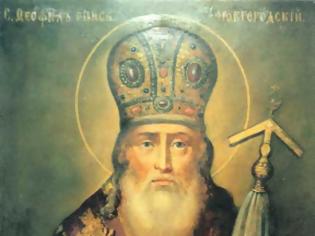2017-10-26 20:55:50

Saint Theophilus of the Kiev Caves was chosen Archbishop of Novgorod by lot after the death of the holy hierarch Jonah (Nov. 5).
He was elevated to the dignity of Archbishop of Novgorod on December 15, 1472 at Moscow. Until his elevation, he had pursued asceticism in the Otensk Monastery and was protodeacon under Archbishop Jonah and sacristan of the monastery.
A harsh destiny was allotted the Saint in the guidance of the Novgorod flock. The mayor Martha Boretskaya and her adherents stirred up and agitated the people against the Great Prince of Moscow, Ivan III. The monk Pimen, a Boretskaya partisan, roused enmity against the archbishop in the flock. Some of the Novgorod populace were inclined to go over to the side of Lithuania. Unfaithful to the Moscow principality, they were prepared to fall into apostasy.
Saint Theophilus stopped the rebellious Novgorodians saying, “Do not betray Orthodoxy nor become a flock of apostates
. I’ll go back to my humble cell, from which you drew me out to the shame of rebellion.” This letter of disavowal of the Saint, written in 1479, is preserved. The short-sighted people did not heed the words of the pastor, and a fratricidal war broke out between Moscow and Novgorod. The defeated Novgorodians were compelled to beg for mercy, and many of them owed their life to the intercession of the Saint. In 1480, Saint Theophilus was sent by Ivan III to prison in the Moscow Chudov Monastery and he sat there a full three years, and died there.
By tradition, when Saint Theophilus lay sick at the Chudov Monastery, Saint Niphon of Novgorod (April 8), who is buried in the Kiev Caves of Saint Anthony, appeared to him in a dream. The Saint reminded him of his promise to venerate the Kievan wonderworkers. It is said that the holy archbishop went to Kiev, and just as he approached the Dniepr his sickness increased. He received a revelation that although he would not reach the Caves alive, his body would rest in them. This was fulfilled, and his relic now rests in the Far Caves.
Information about the spiritual exploits of Theophilus are not preserved; his holiness is confirmed by posthumous miracles from his incorrupt relics recorded in the Kiev Caves Lavra. His relic indicates that he had limited mobility in the hip joints, and probably could not walk on his own at the time of his death. There are also records that may indicate Saint Theophilus, upon his death, was buried in either the Chudov Monastery or in Saint Sophia Cathedral of Novgorod.
Πηγή
paraklisi
He was elevated to the dignity of Archbishop of Novgorod on December 15, 1472 at Moscow. Until his elevation, he had pursued asceticism in the Otensk Monastery and was protodeacon under Archbishop Jonah and sacristan of the monastery.
A harsh destiny was allotted the Saint in the guidance of the Novgorod flock. The mayor Martha Boretskaya and her adherents stirred up and agitated the people against the Great Prince of Moscow, Ivan III. The monk Pimen, a Boretskaya partisan, roused enmity against the archbishop in the flock. Some of the Novgorod populace were inclined to go over to the side of Lithuania. Unfaithful to the Moscow principality, they were prepared to fall into apostasy.
Saint Theophilus stopped the rebellious Novgorodians saying, “Do not betray Orthodoxy nor become a flock of apostates
By tradition, when Saint Theophilus lay sick at the Chudov Monastery, Saint Niphon of Novgorod (April 8), who is buried in the Kiev Caves of Saint Anthony, appeared to him in a dream. The Saint reminded him of his promise to venerate the Kievan wonderworkers. It is said that the holy archbishop went to Kiev, and just as he approached the Dniepr his sickness increased. He received a revelation that although he would not reach the Caves alive, his body would rest in them. This was fulfilled, and his relic now rests in the Far Caves.
Information about the spiritual exploits of Theophilus are not preserved; his holiness is confirmed by posthumous miracles from his incorrupt relics recorded in the Kiev Caves Lavra. His relic indicates that he had limited mobility in the hip joints, and probably could not walk on his own at the time of his death. There are also records that may indicate Saint Theophilus, upon his death, was buried in either the Chudov Monastery or in Saint Sophia Cathedral of Novgorod.
Πηγή
paraklisi
ΦΩΤΟΓΡΑΦΙΕΣ
ΜΟΙΡΑΣΤΕΙΤΕ
ΔΕΙΤΕ ΑΚΟΜΑ
ΣΧΟΛΙΑΣΤΕ


![Μπαρούτι η Καραβάτου με τη Σπυροπούλου: Κρατάω συγκεκριμένη θέση για τους ανθρώπους που μου έχουν... [video]](https://images.newsnowgreece.com/105/1053874/mparouti-i-karavatou-me-ti-spyropoulou-kratao-sygkekrimeni-thesi-gia-tous-anthropous-pou-mou-exoun-video-1-124x78.jpg)











